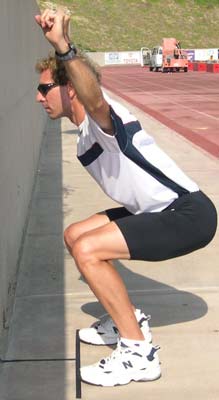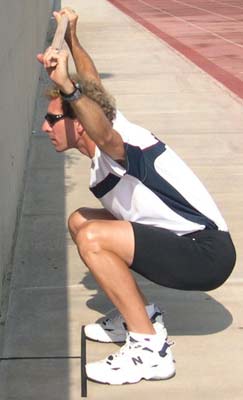| Ron Jones Bio |
| CorporateWellness |
| Coach & Train |
| Exercise Library |
| Handouts |
| Health & Fitness |
| KETTLEBELLS |
| Products by RJ |
| Site Map |
"Overhead Reach Squat"
|
CrossFit Journal Comments: In a 2006 issue of CrossFit Journal, CrossFit founder Greg Glassman made critical and derogatory comments about my overhead reach squat below along with critical and derogatory comments about the National Academy of Sports Medicine (NASM) overhead reach squat. Glassman was writing an article directed towards the progressions of "weighted" squats. NASM and myself are using the overhead reach squat to primarily assess functional movement and to increase shoulder mobility. My page directions clearly stated the above and were not directed to teach anyone about "Olympic" or weighted overhead lifting. Glassman completely took my photos and exercise directions out of context and published them nationally and sold them WITHOUT my permission and WITHOUT giving me the benefit of the doubt--he never even bothered to contact me and ask for an explanation. I don't give a damn about weighted overhead squats when my corporate clients struggle to do a simple body weight squat without compensations. I'm a corporate Wellness coach that gets paid to decrease injuries and reduce corporate liability and OSHA recordable injuries--I'm not being paid to force people into Olympic lifting when they aren't ready. I have a clean record for not hurting people and moving them "better" BEFORE moving them loaded and explosively. Glassman's actions are not appreciated. I stand my ground and will not back down or agree that my squats "are bad" as stated by Glassman. My corporate clients are moving and feeling better and our injuries are decreasing. I'm not good at what I do--I'm great at what I do. I don't make stupid mistakes when it comes to wellness and corporate fitness. Despite Glassman's CrossFit commentary, I DO know better and prove it every single day. Any trainer can go hard and fast. Precious few people exist in this country that can move people better with less pain and give them the self-efficacy to enable permanent behavior change towards a lifestyle of wellness. I'm one of them.
I will
NEVER
recommend CrossFit to
ANY
of my clients whether corporate, adult, child, athletic, or my global
website visitors that can generate up to 260,000+ hits per week. Happy
now Glassman? |
Squats are foundational exercises for leg strength and core development; however, many people cannot do them properly because of weak cores, tight ankles and calves, and/or weak gluteus medius muscles in the deep hips. Remember--the best "free weight" is your own body weight! If you can't do a proper body weight squat then you have no business in the weight room adding more load on top of existing imbalances and resulting compensations. Learn to squat well with body weight--then you'll be able to get optimum results with added loads in the weight room.
The Overhead Reach Body-Weight Deep Squat is a great way to teach proper squat technique while also increasing functional mobility in the shoulders and upper back areas. Simply reach overhead with arms or use a dowel or broomstick while keeping arms straight.
Directions: Perform my
Dynamic Warm-Up
exercises at “beginning” of workout for maximum benefit and improvement.
Pick a safe level; never be unsafe or exceed your capacity to “control” your
body!



Keep knees back so they don't go in
front of knees!
-
Stand upright with feet squarely pointed forward and arms overhead with elbows straight.
-
Lower into squat as you keep weight evenly distributed across feet and reach pole overhead.
-
Keep heels down and don't compensate by allowing your toes to rotate out as you go down!
-
Keep arms straight overhead--the line of your arms should be the same line as your spine.
-
Pause briefly on bottom to stabilize and control movement then come up.
![]() Tips: Keep feet straight forward and square!
Keep heels down while being careful not to sit back or lean forward. Keep
arms straight to actively stretch shoulders and lats. If you are leaning
forward too much, measure out two points 12" from a wall then place down some
tape. Align the center line with your crotch and put your toes on the line.
Squat down and keep your knees behind toes/tape and your face off the wall.
Tips: Keep feet straight forward and square!
Keep heels down while being careful not to sit back or lean forward. Keep
arms straight to actively stretch shoulders and lats. If you are leaning
forward too much, measure out two points 12" from a wall then place down some
tape. Align the center line with your crotch and put your toes on the line.
Squat down and keep your knees behind toes/tape and your face off the wall.
-
People usually ruin what can be a great lower body and core exercise by compensating for imbalances. Common problems are rotating toes out (compensation for tight ankles, or calves, or weak glut medius, or all!). If you struggle to control the low positions you probably also have a weak core as this is a very "balance challenged" position without "the help" of counter balancing your body with the Olympic bar. Keep the arms straight overhead and get those shoulders and lats to stretch through active movement.
-
NO--generally deep squats are NOT bad for you! (Note some people have injuries or limited mobility that prevents them from safely squatting) Thousands of people around the world deep squat every day to use the restroom, work, and carry on conversations. Americans can't deep squat well because we "sit" too much in furniture resulting in core weakness and restricted joint mobility. So get off your butt and squat!
-
Once you can do a proper body weight overhead reach squat with a light pole, you might then consider moving into a weighted squat or weight squat with overhead Olympic bar and plates. Note that weight overhead squats will require even more shoulder mobility to center the weight over your hips as you extend your arms. I'm not concerned with weighted overhead squats in my business of corporate wellness because people struggle enough with just body weight. If you can load and add weight great--but don't do it just to show off at the expense of quality and safety.
-
2008 Comments: I have begun using the Russian Kettlebell primarily for overhead strength and conditioning now. In my opinion, the kettlebells are *superior to Olympic overhead squats, not only for increasing quality of movement, but also for decreasing injuries while increasing functional explosive power. *Let me qualify "Superior" kettlebells--ONLY if they are used according to RKC "HARD" Style standards. If you want to do kettlebells the right way--do them the RKC way--or leave them on the ground before you hurt yourself. Read more about Kettlebell training.
*Note:
This exercise is intended for "normal healthy"
individuals.
If you have an injury, or abnormal pain is present,
see your physician or a certified physical
therapist before continuing your exercises.
RonJones.Org | Back to BodyXercise Library | Site Map
(Updated 10.1.08)
